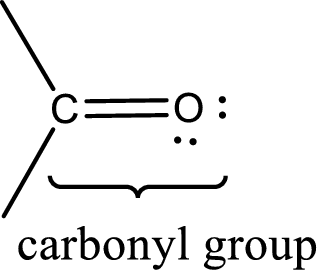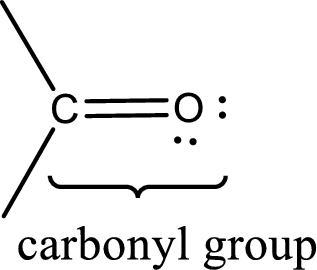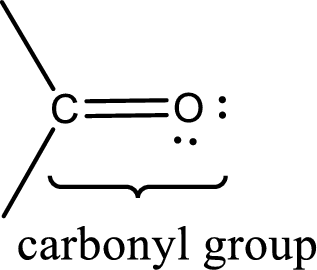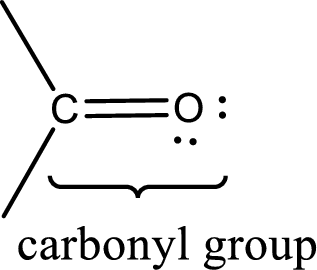
(a)
Interpretation:
Aldehyde must contain the element nitrogen or not has to be indicated.
Concept Introduction:
Carbonyl groups are the one which contain a double bond between carbon and oxygen atom.

The groups that is attached to the carbonyl carbon atom can be either hydrogen or carbon atom. If the attached atoms are hydrogen and a carbon atom means then the compound is an aldehyde and if they are two carbon atoms means then the compound is a ketone. If the attached atom is a nitrogen atom to the carbonyl carbon atom means it is a amide. If a hydroxyl group is attached to a carbonyl carbon atom, then it is a
(b)
Interpretation:
Ketone must contain element nitrogen or not has to be indicated.
Concept Introduction:
Carbonyl groups are the one which contain a double bond between carbon and oxygen atom. Aldehydes and ketones possess this carbonyl functional group in it. The structural representation of a carbonyl group can be given as shown below,

The groups that is attached to the carbonyl carbon atom can be either hydrogen or carbon atom. If the attached atoms are hydrogen and a carbon atom means then the compound is an aldehyde and if they are two carbon atoms means then the compound is a ketone. If the attached atom is a nitrogen atom to the carbonyl carbon atom means it is a amide. If a hydroxyl group is attached to a carbonyl carbon atom, then it is a carboxylic acid. If one of the bond in the carbonyl carbon atom is attached to an oxygen atom that is bonded with alkyl, cycloalkyl or aromatic system is known as ester.
(c)
Interpretation:
Ester must contain element nitrogen or not has to be indicated.
Concept Introduction:
Carbonyl groups are the one which contain a double bond between carbon and oxygen atom. Aldehydes and ketones possess this carbonyl functional group in it. The structural representation of a carbonyl group can be given as shown below,

The groups that is attached to the carbonyl carbon atom can be either hydrogen or carbon atom. If the attached atoms are hydrogen and a carbon atom means then the compound is an aldehyde and if they are two carbon atoms means then the compound is a ketone. If the attached atom is a nitrogen atom to the carbonyl carbon atom means it is a amide. If a hydroxyl group is attached to a carbonyl carbon atom, then it is a carboxylic acid. If one of the bond in the carbonyl carbon atom is attached to an oxygen atom that is bonded with alkyl, cycloalkyl or aromatic system is known as ester.
(d)
Interpretation:
Amide must contain element nitrogen or not has to be indicated.
Concept Introduction:
Carbonyl groups are the one which contain a double bond between carbon and oxygen atom. Aldehydes and ketones possess this carbonyl functional group in it. The structural representation of a carbonyl group can be given as shown below,

The groups that is attached to the carbonyl carbon atom can be either hydrogen or carbon atom. If the attached atoms are hydrogen and a carbon atom means then the compound is an aldehyde and if they are two carbon atoms means then the compound is a ketone. If the attached atom is a nitrogen atom to the carbonyl carbon atom means it is a amide. If a hydroxyl group is attached to a carbonyl carbon atom, then it is a carboxylic acid. If one of the bond in the carbonyl carbon atom is attached to an oxygen atom that is bonded with alkyl, cycloalkyl or aromatic system is known as ester.
Trending nowThis is a popular solution!

Chapter 4 Solutions
Organic And Biological Chemistry
- Why does the anhydride react with the OH on the benzene rather than the OH on the carboxy group?arrow_forwardAnswer the followings: 1- What is the IP for a amino acid? Give example. 2- What are the types of amino acids? 3- What are the structures of protein? 4- The N-Terminal analysis by the Edman method shows saralasin contains sarcosine at the N- terminus. Partial hydrolysis of saralasin with dilute hydrochloric acid yields the following fragments: Tyr-Val-His Sar-Arg-Val His-Pro-Ala Val-Tyr-Val Arg-Val-Tyr What is the structure of saralasin? 5. MATCH a term from the list below to each definition. Place the letter of the term in the blank to the left of the definition. a. Ligases b. Fibrous proteins c. Conjugated protein d. Hydrolases a. b. C. e. Simple protein f. Globular proteins g. Lyases h. Transferases Proteins that are tough and insoluble in water. Enzymes that catalyze the breaking away of a small molecule such as from a substrate. Enzymes that catalyze the bonding together of two substrates.arrow_forwardAnswer the followings (Four): 1-What is the difference(s) between FOUR: a. Glyceride and phosphoglyceride. b. Wax and fat. c. Soap and fatty acid. d. HDL and LDL cholesterol e. Phospho lipids and sphingosine. 2-What are the types of lipids? 3-What are the main lipid components of membrane structures? 4-How could lipids play important rules as signaling molecules and building units? 5. The Structure variety of Lipids makes them to play significant rules in our body. Conclude briefly on this statement.arrow_forward
 Organic And Biological ChemistryChemistryISBN:9781305081079Author:STOKER, H. Stephen (howard Stephen)Publisher:Cengage Learning,
Organic And Biological ChemistryChemistryISBN:9781305081079Author:STOKER, H. Stephen (howard Stephen)Publisher:Cengage Learning, General, Organic, and Biological ChemistryChemistryISBN:9781285853918Author:H. Stephen StokerPublisher:Cengage LearningChemistry: Matter and ChangeChemistryISBN:9780078746376Author:Dinah Zike, Laurel Dingrando, Nicholas Hainen, Cheryl WistromPublisher:Glencoe/McGraw-Hill School Pub Co
General, Organic, and Biological ChemistryChemistryISBN:9781285853918Author:H. Stephen StokerPublisher:Cengage LearningChemistry: Matter and ChangeChemistryISBN:9780078746376Author:Dinah Zike, Laurel Dingrando, Nicholas Hainen, Cheryl WistromPublisher:Glencoe/McGraw-Hill School Pub Co
 World of Chemistry, 3rd editionChemistryISBN:9781133109655Author:Steven S. Zumdahl, Susan L. Zumdahl, Donald J. DeCostePublisher:Brooks / Cole / Cengage Learning
World of Chemistry, 3rd editionChemistryISBN:9781133109655Author:Steven S. Zumdahl, Susan L. Zumdahl, Donald J. DeCostePublisher:Brooks / Cole / Cengage Learning Chemistry: The Molecular ScienceChemistryISBN:9781285199047Author:John W. Moore, Conrad L. StanitskiPublisher:Cengage Learning
Chemistry: The Molecular ScienceChemistryISBN:9781285199047Author:John W. Moore, Conrad L. StanitskiPublisher:Cengage Learning





